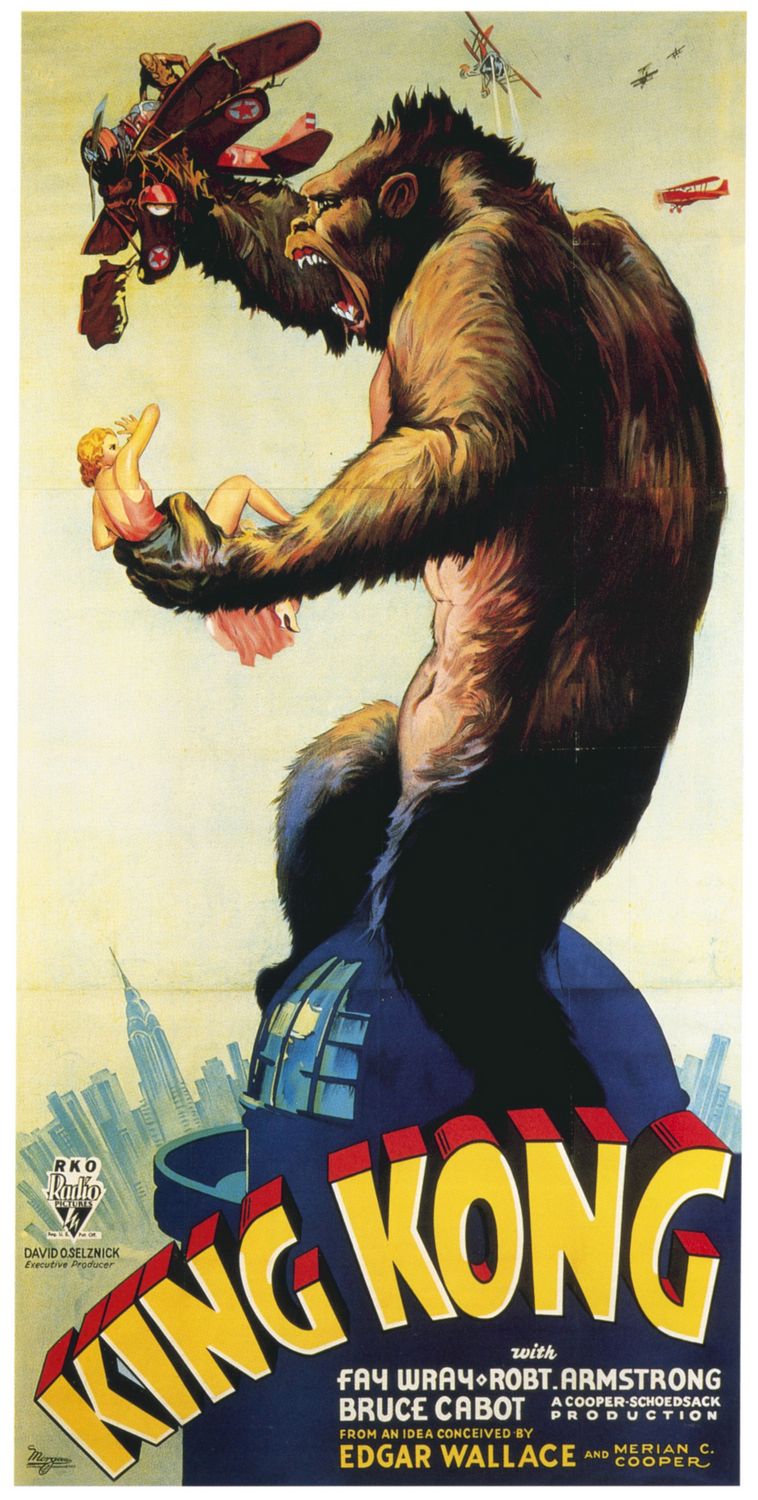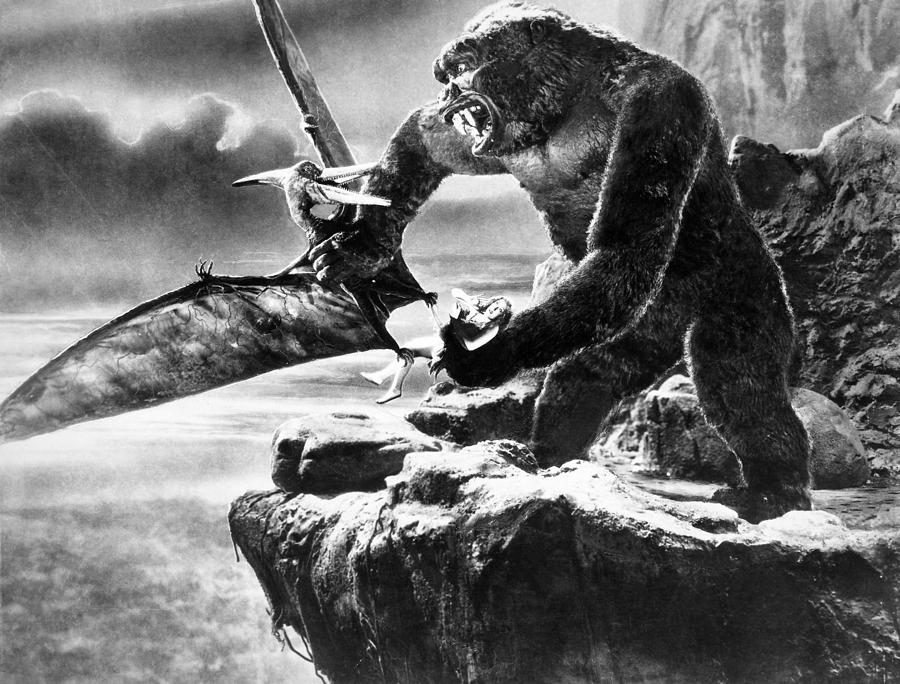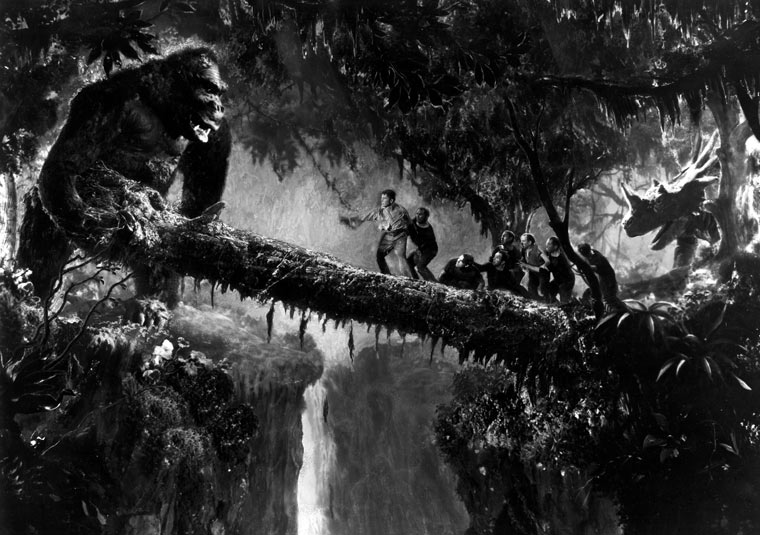It becomes impossible to take this review any further without mentioning the ground breaking special effects in King Kong, from vast mountainous landscapes and structures to epic monster battles Kong has it all. One of the most monumental scenes in the entire film is the intense battle between Kong himself and one of the islands most threatening inhabitants, the Tyrannosaurus Rex. Models and stop motion animation beautifully bring the giants to life as they battle over Ann, whilst the technique may look dated when viewed in the present day, it creates an authentic edge to the creatures that still completely immerses you in the competition over the cowering damsel in distress. "And it is not stingy with the effects; after a half-hour of lumbering dialogue and hammy acting, the movie introduces Kong and rarely cuts away from sequences requiring one kind of trickery or another." (Ebert, 2002) It would seem that Ebert is describing the director's ambition more than anything else in this quote as it becomes obvious throughout the film that the special effects used were thought of as incredibly ground breaking and something audiences would want to see lots of. After years of special effects inspired by scenes from this epic, it would seem they were correct.
When this movie was created there is no doubt that the film's 'monster' would stand out amongst the crowd, not only does Kong's appearance start a vast library of monster giants but his motives also differ from other villainous characters of his time. If you were to compare the 1933 Kong to the character of Dr. Caligari from Robert Weine's 1920 film The Cabinet of Dr. Caligari you would obviously find a difference in appearance, but also a difference in villainous status, which could be considered strange when noticing that the film's are only a mere thirteen years apart. Where as Dr Caligari seems determined to menace the town and cause chaos amongst its civilians Kong couldn't differ more, as it is truly the human race that provoked Kong into destroying anything insight as after all, it was members of our civilisation took Kong out of his home and into a foreign land. It is worth noticing that both Kong and the travelling sailor party could be depicted as the villain of the piece.
"He kidnaps Wray and rampages over the island until he is captured and taken to New York to be put on show" (Haflidison, 2001), Haflidison's use of the phrase 'put on show' perfectly enhances this point, for it is Denham who puts this beast 'on show' and in the doing so places a monster in the presence of the inhabitants. With this in mind it actually becomes easier to compare Denham himself to Caligari, as Caligari intentionally uses his puppet ceaser to reek havoc, Denham unintentionally passes the civilians of New York City over to Kong.
After viewing King Kong you begin to see the lasting effects it has had on future movies to come, from the likes of Godzilla to Jurassic Park. From incredible state of the art special effects to towering creatures that not only capture an audience but also manage to physically petrify them, Kong has it all and has in theory past it all on to future generations to enjoy and revel in. "And over the years, "King Kong" has come to epitomize one of Hollywood's earliest, best and funniest (often unintentionally so) attempts at horror fantasy" (Challon Smith, 1991) this quote seems to sum up the points this review is trying to push across, although the special effects and themes may be laughable to an audience of the 21st century, it remains to this day nothing less than a genre defining classic.
Bibliography
Egbert, R, (2002), King Kong
http://www.rogerebert.com/reviews/great-movie-king-kong-1933 Accessed on: 6/10/15
Halfidison, A, (2001), King Kong
http://www.bbc.co.uk/films/2001/01/30/king_kong_1933_review.shtml Accessed on: 6/10/15
Challon Smith, M, (1991), Everything's Monkey-Dorey in "Kong"
http://articles.latimes.com/1991-10-24/news/ol-253_1_king-kong Accessed on: 6/10/15
Illustration list
Poster, King Kong,
http://www.impawards.com/1933/king_kong_ver8.html Accessed on: 6/10/15
Screenshot, King Kong,
http://fineartamerica.com/featured/4-king-kong-1933-granger.html Accessed on: 6/10/15
Screenshot, King Kong,
http://cinentransit.com/el-cine-a-ojos-de-un-nino/king-kong-1933/ Accessed on: 6/10/15




Well-written review Lewis :) Interesting comparison between Dr Caligari and Kong as the villains of the respective films...
ReplyDeleteDon't forget to italicise your quotes!
...and don't forget to label your images, and link them to the corresponding references in the Illustrations List :)
ReplyDelete